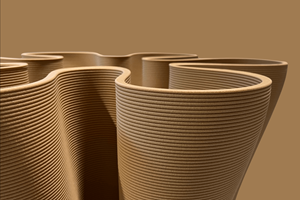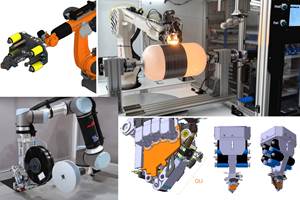Scaled Composites Model 437 aircraft to be flown for Beacon autonomy testbed
Northrop Grumman subsidiary part of Digital Pathfinder development of stealth aircraft with wings using continuous carbon fiber additive manufacturing and determinate assembly.
Source | Northrop Grumman, Siemens, Electroimpact, Scaled Composites
Northrop Grumman (Falls Church, Va., U.S.) has announced it will use the Model 437 aircraft built by subsidiary Scaled Composites (Mojave, Calif., U.S.) to test its Beacon autonomy ecosystem this year. This pioneering system will be tested in a pioneering aircraft — most likely the first to use continuous carbon fiber additive manufacturing in primary structures, namely the wings — showcasing Northrop Grumman’s investment and achievements via its and Advanced Manufacturing teams.
Beacon is built on more than 500,000 autonomous flight hours and integrates advanced autonomous software and solutions within a digital environment that aims to accelerate software deployment, reduce risk and improve readiness for future aircraft programs.
Six partners — Applied Intuition, Autonodyne, Merlin, Red 6, Shield AI and SoarTech, an Accelint company — will test and refine their solutions using the Model 437 with Northrop Grumman’s flight autonomy hardware during a series of flight demonstrations this year.
Model 437 via Digital Pathfinder
According to the , Model 437 began as a conceptual design exploring a multi-mission low-cost attritable aircraft, with Vanguard as a crewed variant. The 41-foot-long aircraft has a 41-foot wingspan, gross takeoff weight of 10,000 pounds and is powered by a single 3,400-pound-thrust Pratt & Whitney engine.
It was also a key demonstrator for the Digital Pathfinder team to develop an innovative stealth aircraft using a fully connected digital environment. The integration of digital tools and processes combined with advanced manufacturing techniques enabled the Model 437 to be built faster and more affordably. Indeed, its first flight in August 2024 was just 27 months after starting the project.
As explained in the 2024 Breaking Defense article, , Northrop Grumman led design, build and manufacturing of the aircraft’s removable wing assemblies while Scaled Composites managed aerodynamic and structural analysis, fuselage and empennage fabrication, aircraft assembly and systems integration as well as ground and flight tests.
AM composite and titanium wings
Northrop Grumman fellow in advanced manufacturing, Eric Barnes, explained in a how new targeted determinate assembly techniques and composite AM processes were used to build the aircraft’s wings.
“We utilized fully digital information through our patented Scalable Composite Robotic Additive Manufacturing (SCRAM) capability that required no hard tooling,” he says, “only a rapidly deposited polymer wash away tool. Combined with no secondary cures or autoclaves needed in this process, we greatly reduced cost and schedule timelines.”
Electroimpact’s SCRAM additive manufacturing system in 2020. See “Combining AFP with 3D printing ...”
“We have multiple patents associated with this continuous fiber additive manufacturing cell. One of these patents allows machines to switch between materials, laying down continuous fiber composites in true 3D form. This enables us to align fibers with load directions, producing lighter, stronger structures with less material.” — Eric Barnes, in 2024 Breaking Defense article
“We also incorporated Plasma Arc Directed Energy Deposition [using] titanium for some of the primary structure of the wing,” said Barnes, “which we believe was the first time this process was used in a defense primary structural application. Through this we are seeing a 30% reduction in cost and schedule timelines for these parts, compared to traditional processes.”
Digital thread, determinate assembly
Sarah Beaudin, DPF director at Northrop Grumman, noted in the Breaking Defense article that in today’s world, the ability to deliver high-tech, high-end aircraft/aerospace solutions within tighter timelines is imperative. “Digital engineering makes that possible,” she added. “Our digital environment provides near-real-time visibility, creating a single source of truth. This allows us to adopt a shift-left approach — iterating everything from design through sustainment as early as possible in the program. By the time we actually start building things, we’ve already got it right.”
“We integrated suppliers into the digital transformation collaborative toolset,” Barnes explained. “This was a game-changer in many ways. To perform determinant assembly effectively, we need to push digital collaboration down to our suppliers, integrating them into our digital toolsets.”
This capability reduced not only the timeline but also costs. “Typical programs budget 15-20% for engineering rework,” said Beaudin. “We saw less than 1%. In addition, we saw improved efficiencies on the manufacturing floor.”
Just as the power of collaboration has been demonstrated by Digital Pathfinder in the Model 437 platform, Beacon will reportedly do the same for autonomy.
“By providing open access to the Beacon ecosystem, we’re enhancing the innovation, new competition and ultimately the autonomous capabilities that industry can deliver to our customers, with unmatched speed and at scale,” — Tom Jones, corporate vice president and president, Aeronautics Systems, Northrop Grumman.
Related Content
Plant tour: Airbus, Illescas, Spain
Airbus’ Illescas facility, featuring highly automated composites processes for the A350 lower wing cover and one-piece Section 19 fuselage barrels, works toward production ramp-ups and next-generation aircraft.
Read MoreSulapac introduces Sulapac Flow 1.7 to replace PLA, ABS and PP in FDM, FGF
Available as filament and granules for extrusion, new wood composite matches properties yet is compostable, eliminates microplastics and reduces carbon footprint.
Read MoreThe next evolution in AFP
Automated fiber placement develops into more compact, flexible, modular and digitized systems with multi-material and process capabilities.
Read MoreCarbon fiber composite pallet revolutionizes freight industry
LOG Point Pallet fuses advanced materials with innovative design and manufacturing to improve supply chains worldwide.
Read MoreRead Next
Scaling up, optimizing the flax fiber composite camper
Greenlander’s Sherpa RV cab, which is largely constructed from flax fiber/bio-epoxy sandwich panels, nears commercial production readiness and next-generation scale-up.
Read MoreCutting 100 pounds, certification time for the X-59 nose cone
Swift Engineering used HyperX software to remove 100 pounds from 38-foot graphite/epoxy cored nose cone for X-59 supersonic aircraft.
Read MoreCeramic matrix composites: Faster, cheaper, higher temperature
New players proliferate, increasing CMC materials and manufacturing capacity, novel processes and automation to meet demand for higher part volumes and performance.
Read More












